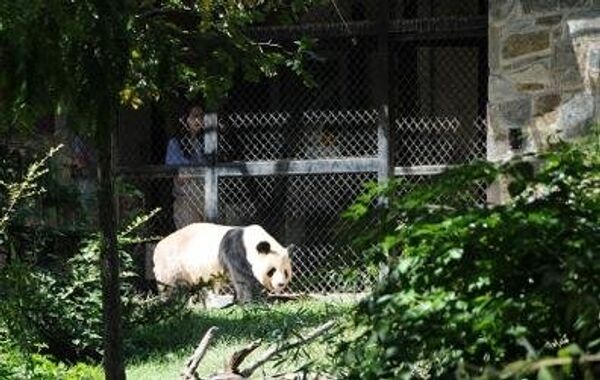Officials at the U.S. National Zoo in Washington, DC said Monday that preliminary necropsy reports from the six-day-old panda that died over the weekend, showed the cub had fluid in its abdomen and abnormalities in its liver.
“We very much appreciate the outpouring of sympathy we have gotten worldwide,” said Dennis W. Kelly on Monday, director of the National Zoo. “We have been working for many years to have a cub, and so we are still just devastated.”
National zoo pathologists performed a necropsy on Sunday after efforts to revive the cub failed that morning. Final results of the report will be received in the next few weeks to determine the exact cause of the animal’s death.
The preliminary report says the cub appeared to be female, and in addition to the fluid in its abdomen, there was also an area of the liver that was hardened.
There was a small amount of milk in the cub’s gastrointestinal tract, and there were no signs of crushing or suffocation, which indicates that the cub’s mother Mei Xiang, “seems to know what she is doing,” said Kelly.
The cub weighed about four ounces (slightly less than 100 grams) and there were no indications of internal or external trauma. The animal’s heart and lungs appeared to also be healthy, the National Zoo stated in a press release on Monday.
The cub appeared to be healthy on Sunday shortly before 9 a.m. when National Zoo officials heard the animal make a noise. But, 17 minutes later Mei Xiang uttered a distressed sound and then moved away from the nesting area.
A zoo veterinarian performed heart massage on the small cub, which was about the size of a stick of butter, but the animal was pronounced dead at 10:28 a.m.
The mortality rate for pandas during their first year of life is 26 percent for males and 20 percent for females, according to the National Zoo.
The cub was conceived through artificial insemination, and both Mei Xiang and Tian Tian, the father, were loaned to the zoo from China. Both bears were also parents to Tai Shan, born in 2005, the first panda cub delivered at the National Zoo to successfully live more than a few days.
Tai Shan now lives at the China Conservation and Research Centre for the Giant Panda in Wolong, China.
“We are in close contact with our Chinese colleagues and together we are trying to learn as much as we can from this unfortunate death,” said Kelly.
The giant panda is the rarest member of the bear family, according to the World Wildlife Federation website. There are only about 1,600 left in the wild, mainly in China, and there are another 300 pandas that live in zoos throughout the world.
“The panda bear is the poster child for the endangered species list,” said Gigi Garver on Monday, who was visiting the National Zoo from Albany, New York. “He is probably the prettiest and cutest of all of them, and every child and adult can relate to him.”
The David M. Rubenstein Giant Panda Habitat is currently closed at the National Zoo, but once Mei Xiang returns to “normal behaviors” visitors will be able to enter the area again, the zoo stated Monday in a press release.
“She has been drinking and eating a little bit,” said Kelly of Mei Xiang. “She is still cradling a toy as if it were her cub, which is what we would expect.”




